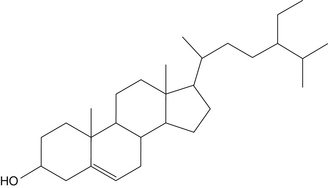Chapter 129 Urtica dioica (Stinging Nettle)
Urtica dioica ssp. dioica (family: Urticaceae)
Common names: stinging nettle, nettle, great nettle
 Chemical Composition
Chemical Composition
Nettle leaves are known to contain flavonoid glycosides (including quercetin and kaempferol), phenylpropanoids (including caffeic malic acid), sterols, carotenoids, vitamins, and minerals.1 The stinging hairs contain formic acid, histamine, serotonin, and choline, among other irritants. Very little is known about the chemistry of the fruits except that they contain protein, carbohydrate, and 30% fatty acids.1
The chemistry of the roots of stinging nettle has been the most thoroughly examined.2 Acidic polysaccharides, lectins, sterols including β-sitosterol, triterpenoids, the coumarin-like compound scopoletin, phenylpropanoids, ceramides, and lignans are all potentially related to the physiologic effects of the roots (Figures 129-1 and 129-2).3 Lignans of potential importance include neoolivil and secoisolariciresinol, which are metabolized by human gut flora to enterodiol and enterolactone, well-characterized phytoestrogenic compounds.4
 History and Folk Use
History and Folk Use
Urtica species have long been employed as medicine in Europe and Asia. The steamed or dried leaves were eaten as a vegetable or seasoning and often still are.4 Nettle fiber was formerly processed into thread used to make clothing, rope, and sailcloth, although it was ultimately replaced by flax. The source of the fiber known as “ramie” comes from the plant Boehmeria nivea, which is also in the Urticaceae family. The word nettle appears to be derived from the old Anglo-Saxon noedl, “needle,” and even before that to the common Indo-European verb ne, “to spin/sew.” There is little record of use of the roots in traditional cultures except as a source of yellow dye.4
Medicinally, stinging nettle leaves were once considered a spring tonic, taken each year in particular by patients with chronic skin or rheumatic conditions.5 The leaves’ diuretic (also ascribed to the fruits), tonifying, lactagogue, antiasthmatic, antihemorrhagic, and “blood-building” properties are consistently referenced by European herbalists.6 Up to modern times, there are descriptions of applications of fresh leaves to aching joints, intentionally causing stings to relieve symptoms. Stinging nettle leaves are also frequently said to promote hair growth.
 Pharmacology
Pharmacology
The two principal effects of stinging nettle leaves are inhibition of inflammation and promotion of diuresis. Most research has involved a proprietary 50% ethanol 10:1 extract of the leaves known as IDS 23 (Strathmann AG & Co, Hamburg, Germany). In vitro, IDS 23 extract and caffeic malic acid inhibit 5-lipoxygenase and cyclooxygenase (isotype not determined); the whole extracts are more potent than caffeic malic acid alone.7 IDS 23 also inhibits the secretion of tumor necrosis factor-α and interleukin-1-β induced by lipopolysaccharide in human blood; phenylpropanoids and flavonoids isolated from the leaves were not effective in this system.8 Perhaps even more important, IDS 23 has been shown to inhibit activation of nuclear factor kappaB (NFkappaB) by preventing degradation of its inhibitory subunit, IkappaB, in vitro.9
In vitro, IDS 23 stimulated production of IL-4 by monocytes and inhibited production of IL-2 and interferon-γ (IFN-γ).10 IL-4 production promotes formation of type 2 helper T cells, which are associated with much less inflammation than type 1 helper T cells. Preliminary in vitro research also shows that nettle leaves are strong antioxidants.11 The multiple inflammation-modulating, immunomodulating, and antioxidant effects of stinging nettle leaves help explain how they could be helpful for so many inflammatory diseases.
A continuous intravenous infusion of an aqueous stinging nettle leaf extract increased natriuresis and urine volume in rats, leading to a reduction in blood pressure.12 In a small uncontrolled trial of patients with congestive heart failure, stinging nettle leaf juice showed a diuretic effect.13 Although much more work is needed, existing data support the traditional belief that stinging nettle leaves are a mild diuretic. An extract combining stinging nettle root and Prunus africanum (pygeum) bark weakly inhibited 5-α-reductase and moderately inhibited aromatase in prostate tissue.14 A separate study found that stinging nettle root extract inhibited aromatase in vitro, although much less potently than Serenoa repens (saw palmetto) extract.15 The two combined showed some additive effects. No effect was noted for another stinging nettle root extract on prostatic α1-adrenergic receptors.16
A double-blind placebo-controlled trial confirms that stinging nettle root extracts inhibit or reduce sex hormone–binding globulin (SHBG) levels in men with benign prostatic hyperplasia (BPH).17 In vitro, ethanolic extracts were shown to decrease the binding of dihydrotestosterone by SHBG.18,19 Lignans and trihydroxyoctadecenoic acids but not triterpenoids were active in this study. These results clearly suggest that multiple active compounds in stinging nettle give this medicinal plant a broad spectrum of effects.
Stinging nettle root extracts have also been repeatedly shown to interfere with binding of epidermal growth factor, a major stimulus of BPH, to its receptor on prostate cells.4,20 Lectins appeared to be the most active compounds isolated in these studies.
 Clinical Applications
Clinical Applications
The major uses of stinging nettle, organized according to the part being used and the route of administration, are shown in Table 129-1.21 Published clinical trial data are available on three of these indications, as discussed here.
Stay updated, free articles. Join our Telegram channel

Full access? Get Clinical Tree





